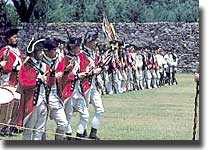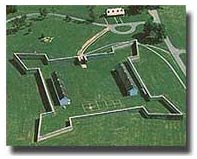Fort Frederick State Park History
 Fort Frederick encapsulates American history from the colonial period to the present and is one of the largest fortifications built by English colonists in North America. The fort's exterior lines are 355 feet from bastion point to bastion point. Its stone wall is about 18 feet high and at least three major buildings originally stood inside that wall.
Fort Frederick encapsulates American history from the colonial period to the present and is one of the largest fortifications built by English colonists in North America. The fort's exterior lines are 355 feet from bastion point to bastion point. Its stone wall is about 18 feet high and at least three major buildings originally stood inside that wall.
Horatio Sharpe, Governor of Maryland, commenced work on the fort in 1756 -- at the outset of the French and Indian War. This war was the culmination of nearly a century of imperial rivalry between France and England over each other's claims in North America and elsewhere over the globe. The two powers had fought three major wars already without final resolution of the issue. Hostilities broke out again in 1754 when a young Virginia militia colonel named George Washington was defeated in western Pennsylvania by a superior force of French. After Washington's defeat, the French unleashed their Indian allies all along the English frontier.
Alarming reports of bloody depredations came flooding into Annapolis. Sharpe, a man of military experience, prevailed upon the Maryland Assembly to vote the funds to build a major fort on the colony's frontier. Sharpe named the fort after Frederick Calvert, who was Lord Baltimore and Proprietor of Maryland. Sharpe also personally directed much of the construction.
The design of the fort conforms to the style developed early in the 18th century by Sebastien de Vauban, a French military engineer who is considered the father of modern fortification.
Building Fort Frederick
Work on Fort Frederick took up the better part of two years. Mounting expenses finally compelled the assembly to cut off funds in 1758, although the fort does seem to have been substantially complete by that time. The English capture of French Fort Duquesne (now Pittsburgh) late that same year relieved the pressure on the Pennsylvania, Maryland, and Virginia frontiers. The war continued, however, further north and on the high seas until 1760 when the English finally took the last major French strongholds in Canada. The Treaty of Paris (1763) formally ended the struggle with England taking possession of most of France's empire, including Canada.
During the French war, a number of different types of troops garrisoned Fort Frederick and the other Maryland frontier posts such as Fort Tonoloway in present day Hancock, Maryland. From time to time, Governor Sharpe called out county militia companies from the more settled parts of the province to do duty on the frontier. Provincial troops from Virginia and North Carolina were billeted at the fort on several occasions. Volunteer ranger companies passed through from time to time. And in one instance a company of royal regulars (from the 60th Regiment of Foot, the "Royal Americans") conveyed a train of artillery stores to the fort and were kept on for a while to help construct roads in the area.
Defending the Fort
The most important group of soldiers to see service at Fort Frederick were the 450 men of the Maryland Forces. This body was composed of men raised and supported by Maryland as provincial regulars. Their field commander was Captain (later Lieutenant Colonel) John Dagworthy. The Maryland troops were efficient and spirited soldiers accustomed to the guerilla style warfare of the frontier. General John Forbes, who commanded the successful expedition against Fort Duquesne, had some of the Maryland men with him and spoke highly of them on several occasions.
 Although no military action occurred at Fort Frederick during the war, it did serve as an important staging area and supply base for English operations further west. After the fall of Duquesne, the Maryland Forces were disbanded and Fort Frederick was closed.
Although no military action occurred at Fort Frederick during the war, it did serve as an important staging area and supply base for English operations further west. After the fall of Duquesne, the Maryland Forces were disbanded and Fort Frederick was closed.
In 1763 the Ottawa Chief Pontiac led a massive Indian rebellion against the English. Governor Sharpe reactivated the fort and sent arms and militia to garrison it. Seven hundred area settlers flocked to the fort for protection. Although the Indians besieged the new English Fort Pitt, which stood on Duquesne's old site, they never got close to Fort Frederick. Pontiac's Rebellion was eventually put down, and Fort Frederick again found itself abandoned.
During the next decade, the English colonists in America grew increasingly at odds with England over the home government's changes in imperial policy. By 1775 the Americans were in open rebellion and in 1776 declared their independence from Great Britain. In 1777 the Continental Congress decided to press Fort Frederick back into military service -- this time as a prison camp. Under the command of Colonel Moses Rawlings, the old fort was refurbished, and captured British troops were imprisoned. By the end of the Revolution, thousands of enemy prisoners were kept there.
After the war, the new State of Maryland sold the fort and surrounding land at public auction. For the next century and more, the land was farmed. A brief interlude during the Civil War saw two companies of Union infantry stationed at the Fort. These troops are believed to have knocked a hole in the south curtain wall through which they trained a cannon toward rebel territory across the Potomac. Confederate troops tried to dislodge the Union soldiers but were unsuccessful.
For much of the 19th and the early 20th centuries, a family of free African-Americans owned and farmed the fort grounds. The family patriarch, Nathan Williams, first bought himself out of slavery, then the woman he would marry. The couple had many children and operated a successful farm.
Restoring
Fort Frederick
 After the Civil War, various patriotic organizations kept the fort's history alive, and in 1922 the State repurchased the crumbling wall and adjacent land to begin development of the present state park. In the 1930's the Civilian Conservation Corps undertook archeology at the fort and rebuilt the wall and the stone foundations of the interior buildings, which had long since disappeared.
After the Civil War, various patriotic organizations kept the fort's history alive, and in 1922 the State repurchased the crumbling wall and adjacent land to begin development of the present state park. In the 1930's the Civilian Conservation Corps undertook archeology at the fort and rebuilt the wall and the stone foundations of the interior buildings, which had long since disappeared.
The restored west barrack in the fort has been furnished as it would have appeared in 1758 when the Maryland troops garrisoned Fort Frederick. The east barrack has been developed into an interpretive center that tells the fort's history through displays. The state plans to continue the fort's restoration in time to celebrate its 250th anniversary in 2006.
The fort is open to visitors daily from Memorial Day to Labor Day and on weekends during the off-season. Special weekday tours for educational groups during the off-season can be arranged through the park's office. Summer activities include performances by volunteer reactivated military units, guided tours, audio-visual programs and a crafts program.
The Friends of Fort Frederick State Park
The Friends of Fort Frederick State Park contributes support to the park by sponsoring educational activities and programs throughout the year, as well as contributing financially to support the park's historical, cultural and administrative needs. Those interested in joining their efforts may contact:
The Friends of Fort Frederick
11115 Fort Frederick Road
Big Pool MD 21711